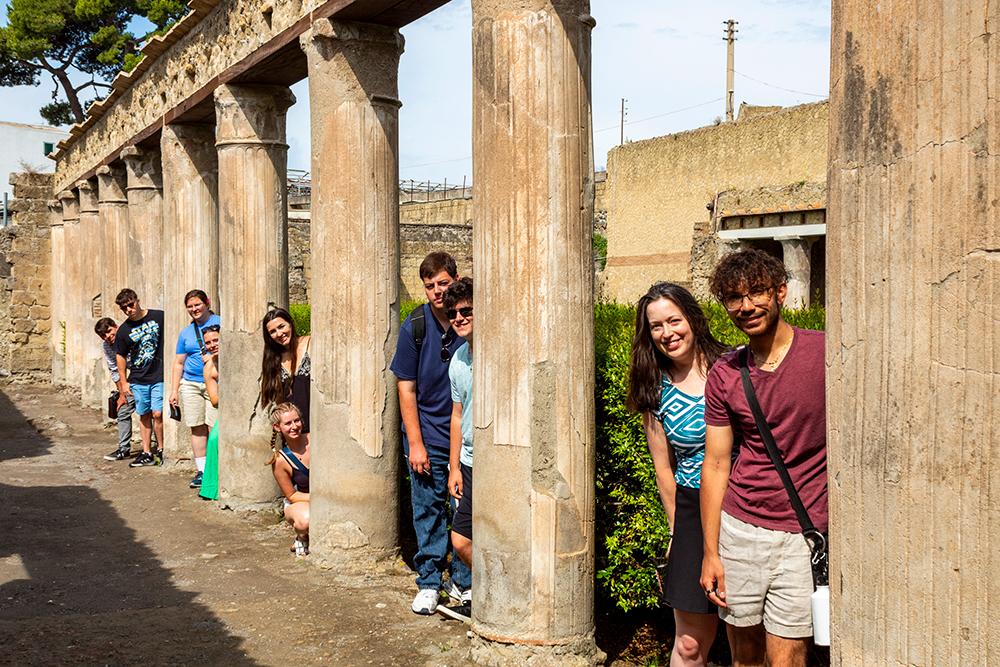Layers of history: Study abroad course brings ancient Italy to life
After a two-year pause, Binghamton’s international education programs are back in full swing

In some ways, the ancient city of Rome is a bit like a layer cake. Take the Basilica of San Clemente, for instance, located a few blocks from the Colosseum.
“Beneath the current Basilica, which was built in the 11th century, are the remains of a 4th-century early Christian Church. Under the 4th-century church lie the remains of an old Roman apartment complex,” explained Aidan Walsh, a senior double-majoring in history and philosophy, politics and law (PPL). “From this one site, you can see the progression of Roman society.”
Walsh and eight other Binghamton University students witnessed history’s complex layers firsthand this summer, through Associate Professor of Middle Eastern and Ancient Mediterranean Studies Hilary Becker’s Ancient Italy in Context course.
It’s the first time since the pandemic that Becker has been able to offer the course through the University’s Study Abroad program. Eleven students attended in 2018 and a dozen had been slated to go in 2020, until the coronavirus halted both international travel and in-person classes.
“After a SUNY-wide two-year pause, we were able to restart Binghamton study abroad programs in spring 2022,” said Associate Director of International Education and Global Initiatives (IEGI) Linda Torricelli. “We are excited to have seen an increase in student traffic and demand for education abroad programs. We had more students visit our office in fall 2022 than in fall 2019.”
All existing programs have since reopened, except for a partnership with Soochow University in China, and several new programs were added. In addition to the students attending Becker’s course, another 54 students attended other programs in Italy this summer, with a total of 162 students studying abroad in programs offered by Binghamton and institutions both within and outside of the SUNY system.
“Pre-pandemic, we would send about 500 students abroad in an academic year, and we look forward to returning to this number and then surpassing it,” Torricelli said.
Study abroad courses such as Becker’s provide an experience that history major Antonio Ferrer ’23 describes as “immersion.” The course was his third study abroad program and allowed him to earn the final credits he needed to graduate — an enjoyable end to his Binghamton experience.
Ferrer also spent two semesters as an education abroad ambassador in the IEGI office. Study abroad is more accessible than many students think, with programs geared to many interests; financial aid is also available, he said.
“Study abroad is an almost essential experience for the type of globalized society in which we live,” Ferrer said.
While the course gave Ferrer an opportunity to get in touch with his Italian heritage, it allowed Abigail Rothleder to spread her wings. A sophomore majoring in PPL and classical civilizations, she loved the class’ visit to Orvieto, noted for its Etruscan and medieval art.
“The most valuable part of this trip, however, was learning how to live more independently, live in a city and explore other countries,” Rothleder reflected. “I left the trip feeling more confident about myself and my future; I can see myself living in Washington, D.C., Boston, or New York City for an internship, further education or a job because I have experience living in an urban setting.”
Italy experienced a historic heat wave during the trip, which the class accommodated with frequent breaks, cold drinks and some tasty gelato.
Along the way, students caught glimpses into intriguing aspects of daily life in ancient days. For example, many towns had a building known as a thermopolium — essentially, an ancient snack bar. Another glimmer of humanity: Some homeowners also would rent the front of their building to vendors, Walsh recounted.
To encompass the sheer lastingness of Roman history, Walsh thinks back on the obelisk which today stands in St. Peter’s Square, once erected by the emperor Caligula nearby more than 2,000 years ago.
“As I stood in line waiting to enter St. Peter’s Basilica, my mind was racing, thinking about all of the history that the obelisk has witnessed,” he said.


